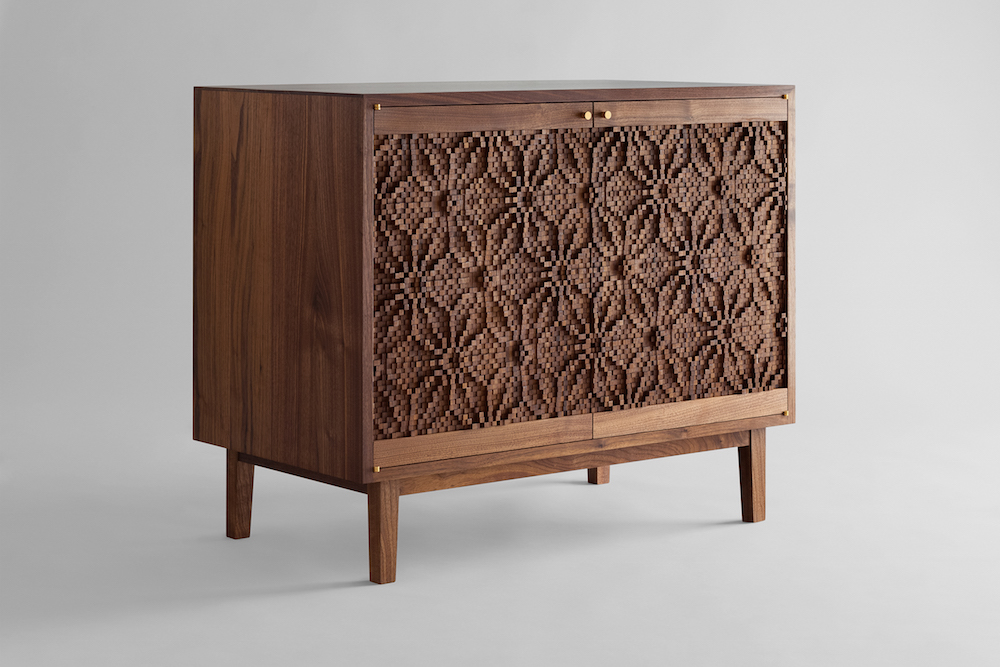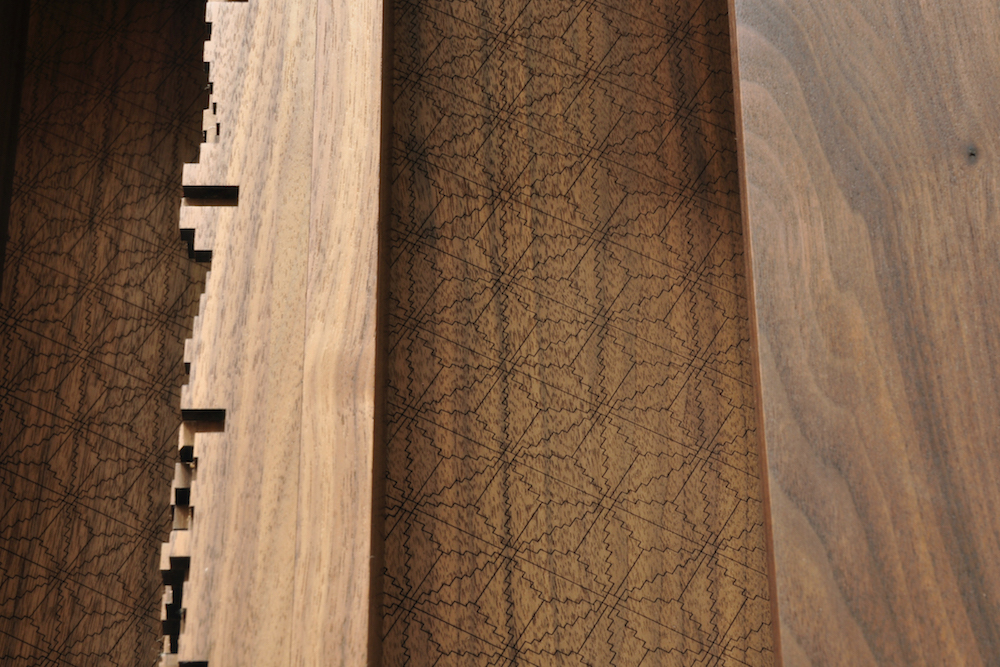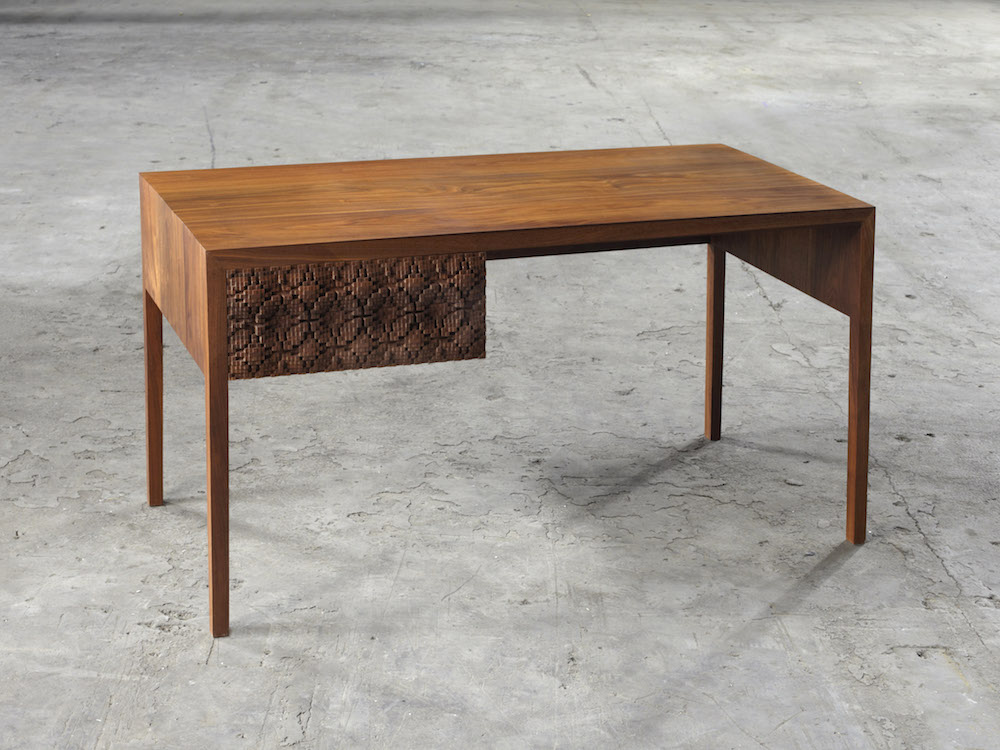We Made It: Furniture Designer & Maker Laszlo Beckett | reviews, news & interviews
We Made It: Furniture Designer & Maker Laszlo Beckett
We Made It: Furniture Designer & Maker Laszlo Beckett
The South London furniture maker talks lasers, skate-ramps and Coltrane
South Londoner Laszlo Beckett is someone for whom design, manufacture, craft, and indeed art, are fairly arbitrary divisions within the creative process. His furniture combines the hyper-modern - particularly in his signature pixellated decorative panels - with meticulous hand-crafting and satisfyingly proportions that reflect a broad knowledge of classic European, Asian and American design.
His ability to seamlessly fuse inspirations and techniques can be illuminated by a look back at his unusual creative apprenticeship as an electronic musician. As part of the Hand On The Plow collective, inspired and supported by electronica mainstay Matthew Herbert, Beckett blended Chicago house and Detroit techno with blues, folk and musique concrète to make a sound that - like his furniture - seemed very new, but somehow outside of time.
JOE MUGGS: How do you describe what you do, e.g. if you're introduced to someone at a party?
LASZLO BECKETT: It rotates between “cabinet maker” and “furniture designer”. Strictly speaking I’m what you’d call a “designer/maker” but that term makes me think of people making felt birds and graphic design-y ceramic cats so I stay clear of that in my opening description.
Can you explain your career path that led you to furniture making?
 I was making skate ramps by stealing ply from building sites at the age of twelve with my friends. We used jigsaws and hand tools to get the job done, crudely but with structural awareness. Later after an art foundation at Camberwell I almost chose a furniture BA but ended up studying photography for my degree, which was more in the fine art camp.
I was making skate ramps by stealing ply from building sites at the age of twelve with my friends. We used jigsaws and hand tools to get the job done, crudely but with structural awareness. Later after an art foundation at Camberwell I almost chose a furniture BA but ended up studying photography for my degree, which was more in the fine art camp.
This led to a stint of graphic design and ten years of music making. Following an epiphany during an Art & Design PGCE at Goldsmiths I remembered that I had mainly hated school first time around and had to get out immediately. I knew that I needed to be doing the making instead of facilitating it, so I fast tracked myself on a private fine furniture course.
Has your involvement with music influenced your approach to your craft in any way? Which musicians/pieces are the most important to you?
I’ve often said, please don’t mention “the C word”Yes it has - specifically with the music which came from Hand on the Plow we often began with field recordings of the world, instruments, people and places which usually instigated the compositions, the organic material birthed the electronic. The ‘Plow' certainly helped us to explore our full toolset (for good or bad sometimes) but our approach to using any tool for the job has definitely influenced my process in designing furniture. A computer, a hand plane, a CNC router, a chisel or a laser engraver it makes no difference in my house. Will Oldham, Captain Beefheart, DJ Deeon, Blind Willie McTell, Bert Jansch, Derrick Carter, Lil’ Louis, Coltrane – “The Promise” – ahh come on, you can’t start making lists like that... they’d be miles long.

So you don't see computer aided design and traditional methods as things to be reconciled – they are all part of the same process for you?
That discussion should have ended in at least 2010! Tools, tools, tools, blah, blah, blah…
What is your favourite part of the design and building process, and why?
The first thirty minutes and the last thirty minutes. The birth of an idea and finally getting rid of it from your brain and workshop is perfect. All the stuff in between is just steering a ship through the rocks.
Do your audience and/or buyers “get” what you set out to do? What are the most interesting responses you've had?
The response to my designs has been very positive and people seem to feel comfortable with the worlds of craft, design, sculpture that I’m work sits in. I intended for the Sarasa Collection to be overwhelming in its detail and for the construction to be slightly unknowable – and people and other designers have really embraced that aspect of the work. A couple of serious furniture manufactures have both wanted to “have” the sculptural panels, but at a lower price point, for their brands. Unfortunately there is no cheap way of doing this in solid wood.
 Who are the designers in any medium that you most admired starting out?
Who are the designers in any medium that you most admired starting out?
George Nakashima, Jean Prouve, Barber & Osgerby and my wife - Jo Hayes Ward
And are there any new/contemporary designers you would really like to big up?
Banarby Barford, Nic Webb, Polly Wales, Gino Saccone
Do you see a generational shift in approach to hand-crafting generally? And how would you like to see this develop in the future?
I’ve often said, please don’t mention “the C word” when discussing my work, but I think the idea of craft being more than knitted animal cushions has finally entered the design and art world in a big way. Craft is finally being respected beyond the craft scene for what it is: knowledge and understanding to transform materials. I think there is a wave of designers now, who are also trained in a particular craft, and they know that the hand can do many things much better than machines and this will ultimately support their design. This wider acceptance of craft as a true commodity is no more evident than the way Heals has been highlighting and elevating UK craft in its products.
Explore topics
Share this article
Add comment
The future of Arts Journalism
You can stop theartsdesk.com closing!
We urgently need financing to survive. Our fundraising drive has thus far raised £49,000 but we need to reach £100,000 or we will be forced to close. Please contribute here: https://gofund.me/c3f6033d
And if you can forward this information to anyone who might assist, we’d be grateful.

Subscribe to theartsdesk.com
Thank you for continuing to read our work on theartsdesk.com. For unlimited access to every article in its entirety, including our archive of more than 15,000 pieces, we're asking for £5 per month or £40 per year. We feel it's a very good deal, and hope you do too.
To take a subscription now simply click here.
And if you're looking for that extra gift for a friend or family member, why not treat them to a theartsdesk.com gift subscription?
more We made it
 We Made It: Guitar Maker Brian Cohen
The incredible one-man string band
We Made It: Guitar Maker Brian Cohen
The incredible one-man string band
 We Made It: Basket-maker Lois Walpole
Weaving works of art from 'ghost gear' and the detritus of consumerism
We Made It: Basket-maker Lois Walpole
Weaving works of art from 'ghost gear' and the detritus of consumerism
 We Made It: Horn Maker Tom Fisher
Bespoke horns, handcrafted in a Derbyshire cellar
We Made It: Horn Maker Tom Fisher
Bespoke horns, handcrafted in a Derbyshire cellar
 We Made It: Stufish Entertainment Architects
From U2 and Madonna to Chinese theatre and the Martian Fighting Machine
We Made It: Stufish Entertainment Architects
From U2 and Madonna to Chinese theatre and the Martian Fighting Machine
 We Made It: 'Carol' Costume Designer Sandy Powell
How she brought a melange of styles to Todd Haynes's sublime period romance
We Made It: 'Carol' Costume Designer Sandy Powell
How she brought a melange of styles to Todd Haynes's sublime period romance
 We Made It: Stuntwoman Tracy Caudle
Forget Evel Knievel: a well-crafted stunt is more about precision than daring
We Made It: Stuntwoman Tracy Caudle
Forget Evel Knievel: a well-crafted stunt is more about precision than daring
 We Made It: 'The Revenant' Production Designer Jack Fisk
How he stunningly recreated the authentic American frontier of 1823
We Made It: 'The Revenant' Production Designer Jack Fisk
How he stunningly recreated the authentic American frontier of 1823
 We Made It: Double Bass Maker Laurence Dixon
Love at first sight, a six-day week and the satisfaction of a job well done
We Made It: Double Bass Maker Laurence Dixon
Love at first sight, a six-day week and the satisfaction of a job well done
 We Made It: The Electric Recording Company
Pete Hutchison's quest for musical perfection on vinyl
We Made It: The Electric Recording Company
Pete Hutchison's quest for musical perfection on vinyl
 We Made It: Watchmaker Roger W Smith
The world-leading horologist keeping British watchmaking alive, crafting exquisite timepieces by hand
We Made It: Watchmaker Roger W Smith
The world-leading horologist keeping British watchmaking alive, crafting exquisite timepieces by hand
 We Made It: Concert hall acoustics
The RSNO have a new concert hall. The lead acoustician explains why it sounds so good
We Made It: Concert hall acoustics
The RSNO have a new concert hall. The lead acoustician explains why it sounds so good
 We Made It: The Headcaster App
Chris Chapman explains the genesis of his animated character app
We Made It: The Headcaster App
Chris Chapman explains the genesis of his animated character app

Comments
Perhaps you should be called